Si Wu
Uncovering Visual-Semantic Psycholinguistic Properties from the Distributional Structure of Text Embedding Spac
May 29, 2025Abstract:Imageability (potential of text to evoke a mental image) and concreteness (perceptibility of text) are two psycholinguistic properties that link visual and semantic spaces. It is little surprise that computational methods that estimate them do so using parallel visual and semantic spaces, such as collections of image-caption pairs or multi-modal models. In this paper, we work on the supposition that text itself in an image-caption dataset offers sufficient signals to accurately estimate these properties. We hypothesize, in particular, that the peakedness of the neighborhood of a word in the semantic embedding space reflects its degree of imageability and concreteness. We then propose an unsupervised, distribution-free measure, which we call Neighborhood Stability Measure (NSM), that quantifies the sharpness of peaks. Extensive experiments show that NSM correlates more strongly with ground-truth ratings than existing unsupervised methods, and is a strong predictor of these properties for classification. Our code and data are available on GitHub (https://github.com/Artificial-Memory-Lab/imageability).
Model Adaptation: Unsupervised Domain Adaptation without Source Data
Feb 26, 2025Abstract:In this paper, we investigate a challenging unsupervised domain adaptation setting -- unsupervised model adaptation. We aim to explore how to rely only on unlabeled target data to improve performance of an existing source prediction model on the target domain, since labeled source data may not be available in some real-world scenarios due to data privacy issues. For this purpose, we propose a new framework, which is referred to as collaborative class conditional generative adversarial net to bypass the dependence on the source data. Specifically, the prediction model is to be improved through generated target-style data, which provides more accurate guidance for the generator. As a result, the generator and the prediction model can collaborate with each other without source data. Furthermore, due to the lack of supervision from source data, we propose a weight constraint that encourages similarity to the source model. A clustering-based regularization is also introduced to produce more discriminative features in the target domain. Compared to conventional domain adaptation methods, our model achieves superior performance on multiple adaptation tasks with only unlabeled target data, which verifies its effectiveness in this challenging setting.
* accepted by CVPR2020
Discrete Prior-based Temporal-coherent Content Prediction for Blind Face Video Restoration
Jan 17, 2025



Abstract:Blind face video restoration aims to restore high-fidelity details from videos subjected to complex and unknown degradations. This task poses a significant challenge of managing temporal heterogeneity while at the same time maintaining stable face attributes. In this paper, we introduce a Discrete Prior-based Temporal-Coherent content prediction transformer to address the challenge, and our model is referred to as DP-TempCoh. Specifically, we incorporate a spatial-temporal-aware content prediction module to synthesize high-quality content from discrete visual priors, conditioned on degraded video tokens. To further enhance the temporal coherence of the predicted content, a motion statistics modulation module is designed to adjust the content, based on discrete motion priors in terms of cross-frame mean and variance. As a result, the statistics of the predicted content can match with that of real videos over time. By performing extensive experiments, we verify the effectiveness of the design elements and demonstrate the superior performance of our DP-TempCoh in both synthetically and naturally degraded video restoration.
Multiple References with Meaningful Variations Improve Literary Machine Translation
Dec 24, 2024Abstract:While a source sentence can be translated in many ways, most machine translation (MT) models are trained with only a single reference. Previous work has shown that using synthetic paraphrases can improve MT. This paper investigates best practices for employing multiple references by analyzing the semantic similarity among different English translations of world literature in the Par3 dataset. We classify the semantic similarity between paraphrases into three groups: low, medium, and high, and fine-tune two different LLMs (mT5-large and LLaMA-2-7B) for downstream MT tasks. Across different models, holding the total training instances constant, single-reference but more source texts only marginally outperforms multiple-reference with half of the source texts. Moreover, using paraphrases of medium and high semantic similarity outperforms an unfiltered dataset (+BLEU 0.3-0.5, +COMET 0.2-0.9, +chrF++ 0.25-0.32). Our code is publicly available on GitHub.
A Differentiable Approach to Multi-scale Brain Modeling
Jun 28, 2024


Abstract:We present a multi-scale differentiable brain modeling workflow utilizing BrainPy, a unique differentiable brain simulator that combines accurate brain simulation with powerful gradient-based optimization. We leverage this capability of BrainPy across different brain scales. At the single-neuron level, we implement differentiable neuron models and employ gradient methods to optimize their fit to electrophysiological data. On the network level, we incorporate connectomic data to construct biologically constrained network models. Finally, to replicate animal behavior, we train these models on cognitive tasks using gradient-based learning rules. Experiments demonstrate that our approach achieves superior performance and speed in fitting generalized leaky integrate-and-fire and Hodgkin-Huxley single neuron models. Additionally, training a biologically-informed network of excitatory and inhibitory spiking neurons on working memory tasks successfully replicates observed neural activity and synaptic weight distributions. Overall, our differentiable multi-scale simulation approach offers a promising tool to bridge neuroscience data across electrophysiological, anatomical, and behavioral scales.
Learning Sequence Attractors in Recurrent Networks with Hidden Neurons
Apr 03, 2024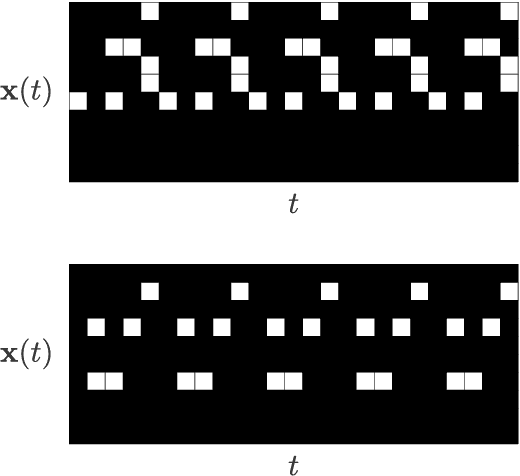

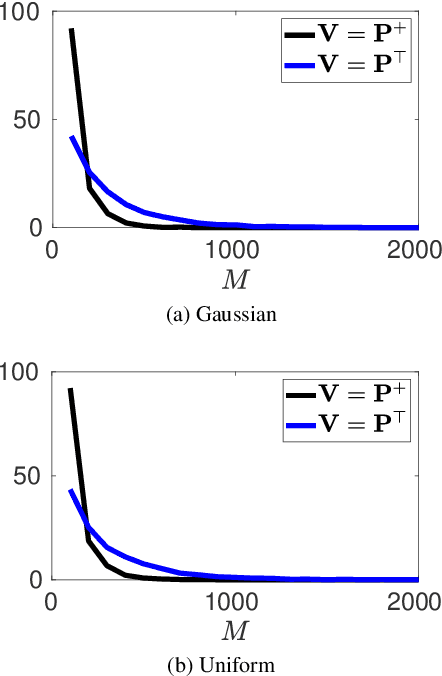
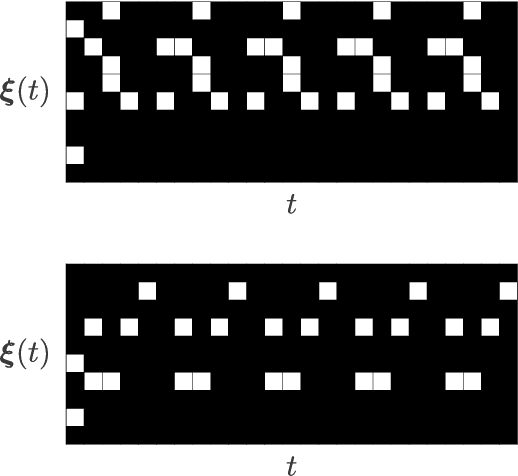
Abstract:The brain is targeted for processing temporal sequence information. It remains largely unclear how the brain learns to store and retrieve sequence memories. Here, we study how recurrent networks of binary neurons learn sequence attractors to store predefined pattern sequences and retrieve them robustly. We show that to store arbitrary pattern sequences, it is necessary for the network to include hidden neurons even though their role in displaying sequence memories is indirect. We develop a local learning algorithm to learn sequence attractors in the networks with hidden neurons. The algorithm is proven to converge and lead to sequence attractors. We demonstrate that the network model can store and retrieve sequences robustly on synthetic and real-world datasets. We hope that this study provides new insights in understanding sequence memory and temporal information processing in the brain.
AttriHuman-3D: Editable 3D Human Avatar Generation with Attribute Decomposition and Indexing
Dec 06, 2023

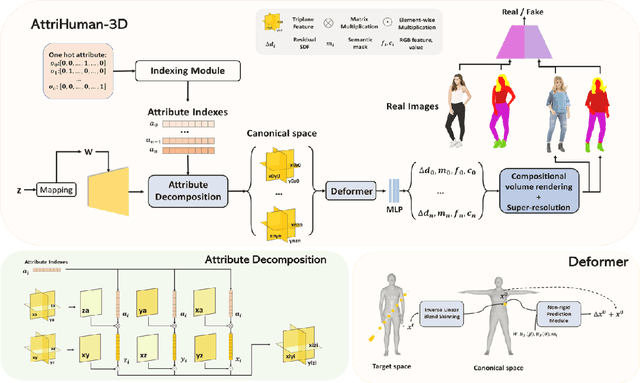

Abstract:Editable 3D-aware generation, which supports user-interacted editing, has witnessed rapid development recently. However, existing editable 3D GANs either fail to achieve high-accuracy local editing or suffer from huge computational costs. We propose AttriHuman-3D, an editable 3D human generation model, which address the aforementioned problems with attribute decomposition and indexing. The core idea of the proposed model is to generate all attributes (e.g. human body, hair, clothes and so on) in an overall attribute space with six feature planes, which are then decomposed and manipulated with different attribute indexes. To precisely extract features of different attributes from the generated feature planes, we propose a novel attribute indexing method as well as an orthogonal projection regularization to enhance the disentanglement. We also introduce a hyper-latent training strategy and an attribute-specific sampling strategy to avoid style entanglement and misleading punishment from the discriminator. Our method allows users to interactively edit selected attributes in the generated 3D human avatars while keeping others fixed. Both qualitative and quantitative experiments demonstrate that our model provides a strong disentanglement between different attributes, allows fine-grained image editing and generates high-quality 3D human avatars.
A differentiable brain simulator bridging brain simulation and brain-inspired computing
Nov 09, 2023

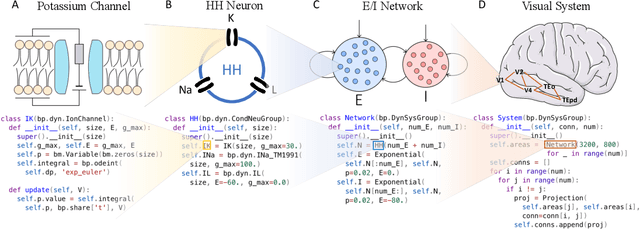

Abstract:Brain simulation builds dynamical models to mimic the structure and functions of the brain, while brain-inspired computing (BIC) develops intelligent systems by learning from the structure and functions of the brain. The two fields are intertwined and should share a common programming framework to facilitate each other's development. However, none of the existing software in the fields can achieve this goal, because traditional brain simulators lack differentiability for training, while existing deep learning (DL) frameworks fail to capture the biophysical realism and complexity of brain dynamics. In this paper, we introduce BrainPy, a differentiable brain simulator developed using JAX and XLA, with the aim of bridging the gap between brain simulation and BIC. BrainPy expands upon the functionalities of JAX, a powerful AI framework, by introducing complete capabilities for flexible, efficient, and scalable brain simulation. It offers a range of sparse and event-driven operators for efficient and scalable brain simulation, an abstraction for managing the intricacies of synaptic computations, a modular and flexible interface for constructing multi-scale brain models, and an object-oriented just-in-time compilation approach to handle the memory-intensive nature of brain dynamics. We showcase the efficiency and scalability of BrainPy on benchmark tasks, highlight its differentiable simulation for biologically plausible spiking models, and discuss its potential to support research at the intersection of brain simulation and BIC.
Neural Sampling in Hierarchical Exponential-family Energy-based Models
Oct 22, 2023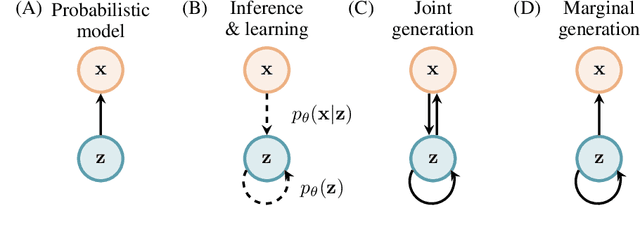
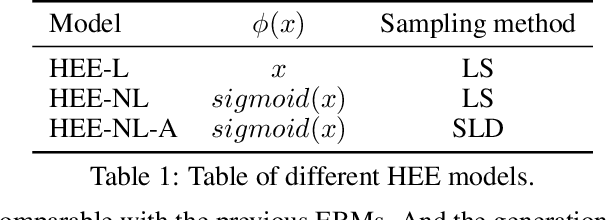
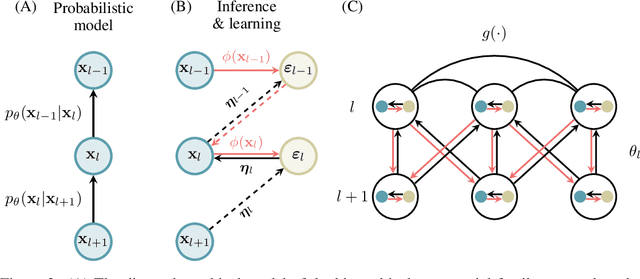
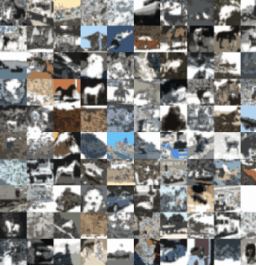
Abstract:Bayesian brain theory suggests that the brain employs generative models to understand the external world. The sampling-based perspective posits that the brain infers the posterior distribution through samples of stochastic neuronal responses. Additionally, the brain continually updates its generative model to approach the true distribution of the external world. In this study, we introduce the Hierarchical Exponential-family Energy-based (HEE) model, which captures the dynamics of inference and learning. In the HEE model, we decompose the partition function into individual layers and leverage a group of neurons with shorter time constants to sample the gradient of the decomposed normalization term. This allows our model to estimate the partition function and perform inference simultaneously, circumventing the negative phase encountered in conventional energy-based models (EBMs). As a result, the learning process is localized both in time and space, and the model is easy to converge. To match the brain's rapid computation, we demonstrate that neural adaptation can serve as a momentum term, significantly accelerating the inference process. On natural image datasets, our model exhibits representations akin to those observed in the biological visual system. Furthermore, for the machine learning community, our model can generate observations through joint or marginal generation. We show that marginal generation outperforms joint generation and achieves performance on par with other EBMs.
Composition and Deformance: Measuring Imageability with a Text-to-Image Model
Jun 05, 2023



Abstract:Although psycholinguists and psychologists have long studied the tendency of linguistic strings to evoke mental images in hearers or readers, most computational studies have applied this concept of imageability only to isolated words. Using recent developments in text-to-image generation models, such as DALLE mini, we propose computational methods that use generated images to measure the imageability of both single English words and connected text. We sample text prompts for image generation from three corpora: human-generated image captions, news article sentences, and poem lines. We subject these prompts to different deformances to examine the model's ability to detect changes in imageability caused by compositional change. We find high correlation between the proposed computational measures of imageability and human judgments of individual words. We also find the proposed measures more consistently respond to changes in compositionality than baseline approaches. We discuss possible effects of model training and implications for the study of compositionality in text-to-image models.
 Add to Chrome
Add to Chrome Add to Firefox
Add to Firefox Add to Edge
Add to Edge